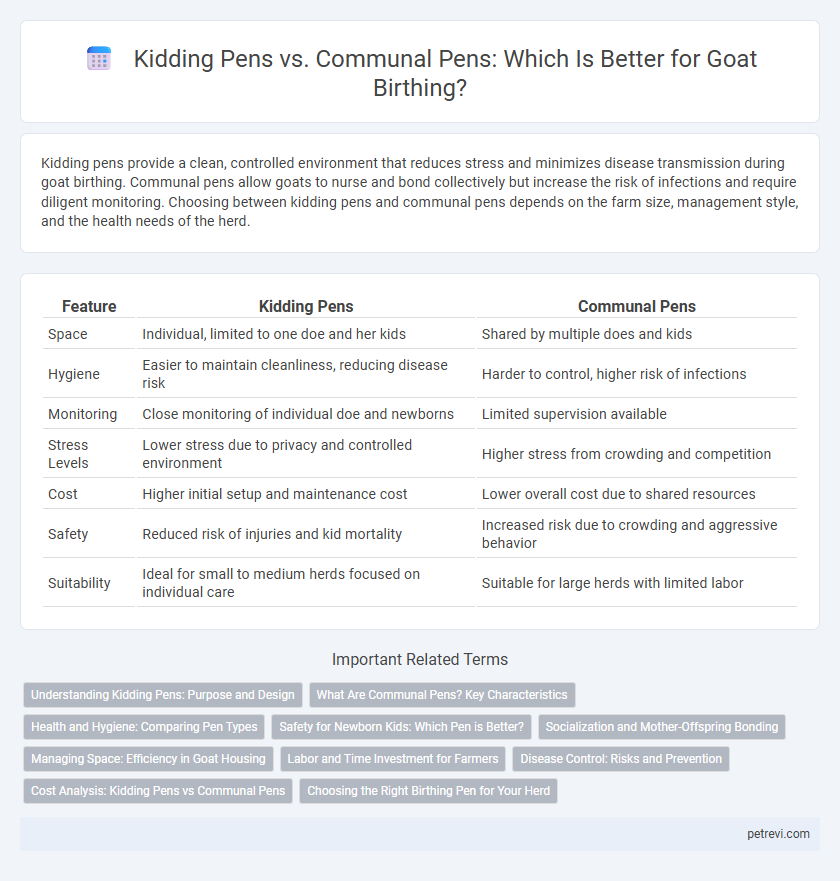Kidding pens provide a clean, controlled environment that reduces stress and minimizes disease transmission during goat birthing. Communal pens allow goats to nurse and bond collectively but increase the risk of infections and require diligent monitoring. Choosing between kidding pens and communal pens depends on the farm size, management style, and the health needs of the herd.
Table of Comparison
| Feature | Kidding Pens | Communal Pens |
|---|---|---|
| Space | Individual, limited to one doe and her kids | Shared by multiple does and kids |
| Hygiene | Easier to maintain cleanliness, reducing disease risk | Harder to control, higher risk of infections |
| Monitoring | Close monitoring of individual doe and newborns | Limited supervision available |
| Stress Levels | Lower stress due to privacy and controlled environment | Higher stress from crowding and competition |
| Cost | Higher initial setup and maintenance cost | Lower overall cost due to shared resources |
| Safety | Reduced risk of injuries and kid mortality | Increased risk due to crowding and aggressive behavior |
| Suitability | Ideal for small to medium herds focused on individual care | Suitable for large herds with limited labor |
Understanding Kidding Pens: Purpose and Design
Kidding pens are specialized enclosures designed to provide a clean, quiet, and controlled environment for goat birthing, reducing stress and minimizing disease risks for newborn kids and does. These pens typically include soft bedding, adequate space for movement, and easy access for monitoring and assistance during labor, ensuring optimal health outcomes. Proper design incorporates isolation from the main herd to prevent contamination while facilitating warmth and safety essential for successful kidding.
What Are Communal Pens? Key Characteristics
Communal pens for goat birthing are shared enclosures where multiple does give birth and raise their kids together. These pens are designed to promote social interaction, allow easier group management, and provide a more natural environment that mimics herd conditions. Key characteristics include open space, shared bedding, and accessible feed areas to support both the does and their newborn kids.
Health and Hygiene: Comparing Pen Types
Kidding pens provide a controlled, clean environment that minimizes disease transmission and supports newborn goat health by limiting exposure to pathogens. Communal pens increase the risk of infection due to shared bedding and close contact with multiple does and kids, leading to higher chances of parasite load and respiratory issues. Effective sanitation and regular bedding changes in kidding pens enhance hygiene, making them preferable for biosecurity during the critical birthing period.
Safety for Newborn Kids: Which Pen is Better?
Kidding pens provide a controlled and clean environment, significantly reducing the risk of injury and disease transmission for newborn kids compared to communal pens. Individual pens allow for close monitoring of the doe and kid, facilitating timely intervention in case of birthing complications or health issues. Communal pens, while promoting social interaction, increase the likelihood of accidental trampling and exposure to pathogens, making kidding pens a safer choice for newborn goat kids.
Socialization and Mother-Offspring Bonding
Kidding pens provide a controlled environment that enhances mother-offspring bonding by minimizing stress and allowing focused maternal care, which is crucial for the newborn goat's survival and development. Communal pens promote socialization among does and kids, encouraging early interaction and natural herd behaviors but may increase competition and stress for weaker offspring. Balancing the benefits of socialization with the need for secure bonding is essential for optimizing kid health and welfare.
Managing Space: Efficiency in Goat Housing
Kidding pens offer precise control over individual doe birthing spaces, reducing stress and ensuring targeted care during delivery. Communal pens maximize space efficiency by accommodating multiple does simultaneously, yet require vigilant monitoring to prevent overcrowding and ensure adequate access to resources. Optimal goat housing balances the benefits of individual kidding pen management with the space efficiency of communal settings, tailored to herd size and farm resources.
Labor and Time Investment for Farmers
Kidding pens provide a controlled and hygienic environment that can significantly reduce labor during goat birthing by localizing care and monitoring, which minimizes the time spent checking multiple does. Communal pens require more extensive supervision and cleaning efforts, as the mingling of multiple pregnant does increases the risk of complications and disease, thereby raising labor intensity. Farmers benefit from strategic use of kidding pens to streamline labor input and optimize time management during the critical kidding period.
Disease Control: Risks and Prevention
Kidding pens provide a controlled environment that minimizes disease transmission by isolating does during the birthing process, reducing exposure to pathogens common in communal settings. Communal pens increase the risk of disease spread due to higher animal density, shared bedding, and close contact among newborn kids and does. Implementing strict sanitation protocols and regular health monitoring in communal pens is essential to prevent outbreaks of contagious diseases such as caprine arthritis encephalitis and pneumonia.
Cost Analysis: Kidding Pens vs Communal Pens
Kidding pens require higher upfront investment due to individual stalls, specialized bedding, and sanitation measures, but they minimize disease spread and improve kid survival rates, thereby reducing long-term veterinary costs. Communal pens lower initial costs by housing multiple does together but increase the risk of infections and injuries, potentially raising healthcare expenses and affecting overall productivity. Evaluating cost efficiency involves balancing initial setup expenses with ongoing health management and kid mortality rates.
Choosing the Right Birthing Pen for Your Herd
Kidding pens provide a controlled, sanitary space that reduces the risk of disease transmission and allows for individualized care during goat birthing. Communal pens offer more social interaction for does but require vigilant monitoring to prevent overcrowding and complications. Selecting the right pen depends on herd size, management style, and health considerations to ensure a safe environment for both does and kids.
Kidding Pens vs Communal Pens for Goat Birthing Infographic

 petrevi.com
petrevi.com